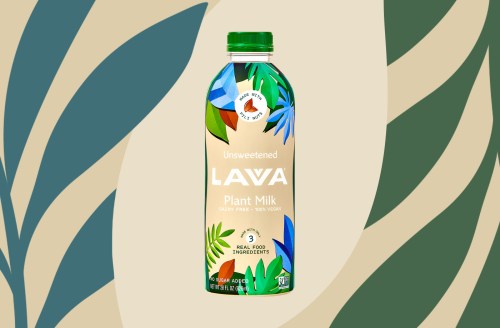Confession: Even as someone whose job it is to write about healthy food for a living, I actually knew next to nothing about pili nuts until recently. Almonds, pecans, macadamia…I got you. But pili nuts is one I can honestly tell you I’ve never hunted down in the grocery store.
Experts in This Article
registered dietitian nutritionist and author of Collagen: Self-Care Secrets to Eat, Drink, and Glow
So why am I thinking about them now? The nuts, which I now know are teardrop shaped nuts sourced from pili trees (native to the Philippines, northern Australia, and parts of Southeast Asia), are now being used to make the newest alternative milk to hit the market. Lavva, known for their dairy-free pili nut yogurts, is expanding its offerings to release pili nut milk ($5.49) and creamer ($3.49) exclusively at Whole Foods, starting September 15.
Check out the video below to see what alternative milk a registered dietitian likes the most:
“After launching our yogurt line, Whole Foods approached us to see if we’d ever tried using the pili nuts to make milk,” Lavva founder and CEO Elizabeth Fisher says. “They thought we could capture the natural emulsification of the nut and be able to avoid using vegetable oils—often polyunsaturated oils that can become unstable when heated—or any phosphates or gums, which are commonly used in alt-milks.” The brand took Whole Foods up on the challenge, and delivered on a brand-new product.
What’s in Lavva’s new pili nut milk?
Lavva created two different pili nut milks: an unsweetened version and a chocolate version. In the unsweetened one, the ingredients are organic coconut water, filtered water, and pili nuts. The chocolate flavor has the same base ingredients, plus unsweetened Fair Trade cacao powder, maca root powder, dates, mesquite powder, and Himalayan sea salt.
Fisher says one major goal the brand had when making the new products was achieving a great-tasting drink without added sugar. This is why, she says, they used coconut water (which is naturally sweet) and not regular H20, which is the base in virtually all other alternative milks. “A chocolate milk of any kind that doesn’t contain added sugars is very special,” she adds. To her point, the sugar content in both milks is low: only 4 grams per serving in the unsweetened version and 6 grams per serving in the chocolate.
“We also wanted to unlock the nutritional profile of the pili nut,” Fisher says. “Pili nuts are a complete protein and contain all eight essential amino acids. They are also rich in magnesium and vitamin E as well as nourishing plant fats, especially monounsaturated fats known to support heart health and brain function.”
Besides putting the nutrients from the pili nuts front and center and not using added sugar, Fisher says sustainability was a major factor in production. Just one liter of almond milk (one of the most popular and most common alt-milks) requires 371 liters of water to produce, according to Oxford University data; that translates to roughly 1400 gallons of water for every gallon of almond milk produced. “In contrast, pili nuts have been wild harvested for centuries and solely require rainwater to sprout and grow, making them a naturally sustainable and regenerative crop.” (Regenerative agriculture methods are good for the environment because they slow soil erosion, help trap more carbon in the soil, and increase biodiversity.)
Sustainable, low in sugar, a good source of magnesium and vitamin E…It all sounded pretty good to me, but I wasn’t going to be fully convinced about the benefits of the latest alternative milk until I had a ringing endorsement from someone who was unbiased.
What a registered dietitian thinks of pili nut milk
Registered dietitian Jessica Bippen, RD, is completely unaffiliated with Lavva and hasn’t tried the new milks. (She has tried their yogurts though and is a fan.) Since she has no connection whatsoever to the company, I trusted hew to give me the nutritional news straight. “From a dietitian’s point of view, pili nuts are very similar nutritionally to almonds,” she tells me.
Bippen says that Lavva’s labeling says that 60 percent of the calories in the milk are coming from the pili nuts, which she likes; many alternative milks are mostly water and actually very low in the nut being used, she points out. “Also, the fact that pili nuts are a complete protein can be helpful to vegans in particular, although hemp is another complete protein source too,” she says.
One serving of the alternative milk has 320 milligrams of potassium, which Bippen says is likely coming from the coconut water and she says this is an added benefit to alternative milks that just use regular H20. (You want to aim to get 2,300 milligrams a day.)
Lavva’s effort to avoid added sugar was well worth it because it definitely impressed Bippen—especially the chocolate milk, which typically is high in sugar. “The maca is a really interesting ingredient, too. It’s one you definitely don’t often see used a lot,” she says. If you’re unfamiliar with it, maca is an herb connected to boosting energy and mood. (Bippen points out that it’s an herb pregnant and nursing people should avoid as there isn’t scientific evidence on whether it’s safe or not for them to consume.)
While the pili nut milk doesn’t have any nutritional red flags, like any alternative milk, Bippen says it isn’t super nutrient-rich, nor does it pack the same benefits as eating a handful of the nuts raw. But hey, if you want to use it in your smoothies or lattes as a dairy-free option, she doesn’t see a problem with it.
How does it taste?
Lavva generously sent me both milks to test so I can give a full report on each. First, I started with the unsweetened version. Pouring it into my glass, the consistency was similar to almond milk; definitely not as thick as oat or cow’s milk. I could smell the slightly sweet coconut water right away and taking a sip, that’s what I tasted the most. The nutty flavor was more of a subtle aftertaste.
Because of the coconut water, that’s truly going to be the deciding factor for if you like this milk. For me personally, I’m not a huge coconut water fan, so it wasn’t my favorite. But I know plenty of people are (I definitely feel like an outlier in the wellness world on this one), so if that’s you, this alternative milk may be right up your alley.
Moving on to the chocolate flavor, this one was a bit thicker than the unsweetened one and even had those frothy little bubbles on top. Because I wasn’t exactly going, ahem, nuts over the unsweetened one, I set my expectations accordingly for the chocolate. But then I took a sip. It was delicious! The coconut water was definitely much more subtle and the cacao powder is majorly front and center. Considering how little sugar—and no added sugar— is in the milk, I was really surprised at how decadently chocolatey it tasted. If you warm this one up for a cup of hot cocoa, you won’t even need to add anything to it!
So there you have it: Everything you need to know about the latest alternative milk coming to stores near you. (Or at least a Whole Foods near you.) If you normally drink almond milk and have been known to stock up on coconut water, it just might be your new, more sustainable go-to. And hey, if not, I’m sure there’s another option out there for you. If there’s one thing the wellness world loves, it’s a good alternative milk.
Oh hi! You look like someone who loves free workouts, discounts for cult-fave wellness brands, and exclusive Well+Good content. Sign up for Well+, our online community of wellness insiders, and unlock your rewards instantly.
Sign Up for Our Daily Newsletter
Get all the latest in wellness, trends, food, fitness, beauty, and more delivered right to your inbox.
Got it, you've been added to our email list.










